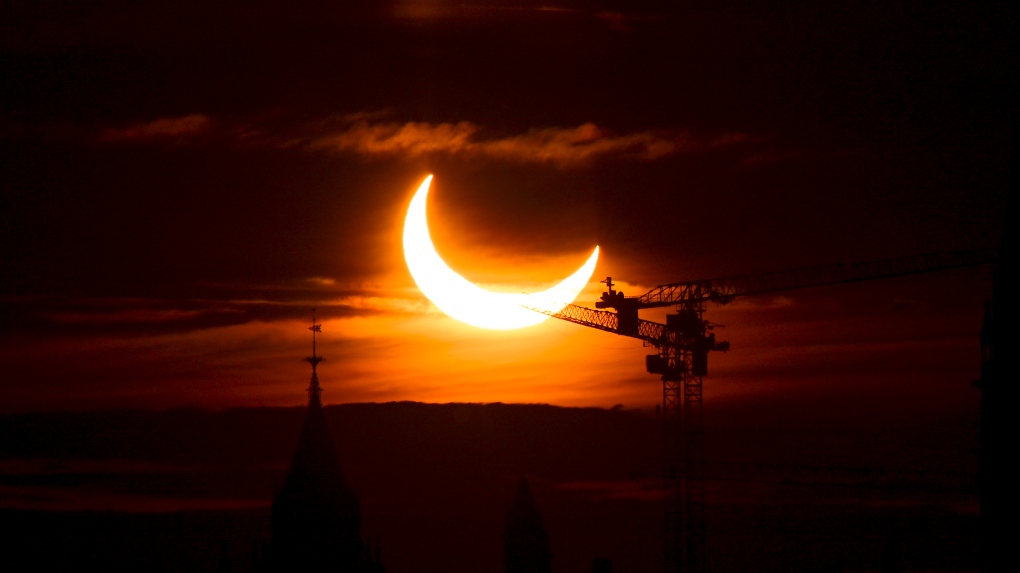For a few precious minutes next Monday, countless Canadians may marvel as the sky darkens and the moon slips directly between the Earth and sun, a rare and remarkable spectacle in the cosmic ballet, not seen in much of Canada for decades.
“It is one of the most fascinating natural phenomena we can observe,” said astronomer Julie Bolduc-Duval in an interview with CTV News Monday. “It’s fantastic that we all get the chance to see it … for free, over our heads.”
But also remarkable are the myriad impacts that a celestial event like April 8th’s solar eclipse can cause, from an associated spike in traffic accidents along its path, to measurable effects on social interactions and the behaviour of wildlife.
Here are a few lessons we’ve learned from eclipses past, and something we’re hoping to better understand this time around:
Say ‘awe’
It’s no secret that eclipses can inspire wonder. But a team of researchers at the University of California, Irvine have found that the emotional impact of an eclipse is actually something that can be measured.
A 2022 data review encompassing millions of social media users during the 2017 solar eclipse showed a notable increase in what researchers called “prosocial, affiliative, humble, and collective language” among those in its path, compared to those outside it.
“Humans have looked toward the sky for inspiration and guidance for millennia,” the study reads. “Awe-inspiring astronomical events such as a total solar eclipse can arouse tendencies — from greater attention to one’s groups to motivations to care for and affiliate with others — vital to collective life.”
Further research found that users who displayed “elevated awe” during and around the eclipse were more likely to use that language, compared both to their own posts online from before the eclipse and less-awed users.
“I love to think about the fact that there will be millions of us looking at the sky at the same time,” Bolduc-Duval said. “There’s so many things kind of splitting, polarizing us, these days. But everyone will be looking up at the eclipse … that’s a really beautiful thought.”
Eyes on the road
While many will step away from their routine to take in the spectacle, many more will experience the eclipse as just another Monday afternoon, at and around rush hour, which could mean they’ll be behind the wheel.
A new study from the University of Toronto (U of T) and University of British Columbia (UBC) found that based on what the last North American total eclipse showed, fascinating visual phenomena and hurtling down the highway simply don’t mix.
“We found a significant increase in traffic risk in the U.S. around the time of the total eclipse,” lead investigator Donald Redelmeier said in a release from U of T.
Examining records from a U.S. database of traffic fatalities, researchers found that traffic risks in their sample spiked by nearly a third in the three-day period around the 2017 eclipse. The spike, they found, equated to an average of one additional crash every 25 minutes, one additional death every 95 minutes and a total of 46 additional fatalities.
Increased traffic, unfamiliar destinations and routes, disproportionate speeding and roadside stops may all factor into the spike, said Redelmeier, who drew a comparison with similar increases to risk around major holidays such as Thanksgiving.
“Clinicians might advise patients to respect speed limits, minimize distractions, allow more headway, wear a seatbelt, and to never drive impaired,” UBC co-investigator John Staples said in the release.
“More broadly, stakeholders should work toward a transportation system that minimizes traffic risks, tolerates human error, and optimized recovery after a crash,” Redelmeier said.
Animal abnormalities
For people across the continent, the eclipse is a long-anticipated event with plenty of warning and centuries of scientific research to help understand its context.
Animals, though, likely won’t get the memo.
Strange behaviour among wildlife has long been anecdotally reported during celestial events like eclipses, from nocturnal animals instinctually assuming that dusk has come early, to a more directionless, panicked response as it will be a totally novel experience for most animals.
For a study published in 2020, a team of U.S. researchers visited Riverbanks Zoo in Columbia, S.C., to monitor 17 species of mammals, birds and reptiles during the 2017 solar eclipse.
They found that roughly three in four of the species exhibited behaviour outside of the norm, with a majority flipping to their natural evening or nighttime routines, and five species, including gorillas, baboons, flamingos, giraffes and parrots, displaying anxious or fearful responses.
A follow-up study is planned for this year’s eclipse.
Researchers with NASA have also studied the impact of the eclipse on the animal kingdom, recruiting human volunteers for the 2023 partial eclipse and again for this April’s total eclipse to monitor the change in natural noise levels and other observations in their region, such as crickets chirping hours ahead of schedule.
The Eclipse Soundscapes Project, itself a revival of a 1930s study, is expected to feature more than 2,000 volunteers across North America this year.
“We are excited to invite the public to participate in this opportunity to perform real and meaningful scientific research as equal participants,” project co-lead Henry “Trae” Winter said in a press release.
Atmospheric waves
Next week’s event is expected to be a beautiful and jaw-dropping sight, but for those who study the atmosphere itself, it presents what could be a far-more exhilarating opportunity: controlled, predictable data.
Researchers at the University of Colorado Boulder (UCB) are planning to use their roughly two-minute window of the total eclipse to measure how solar radiation impacts the ionosphere, a layer of Earth’s atmosphere that stretches from 60 to 1,000 kilometres overhead, and is crucial to the planet’s radio signals.
The eclipse’s brief disruption to the flow of energy from the sun to Earth allows for unique conditions to learn the dynamics of the ionosphere, which may help scientists understand the implications of launching and maintaining satellites, manned missions to space and telecommunications around the world.
“The ionosphere is like a wavy surface in a pool, and by measuring the characteristics of the waves produced there, we can learn more about the pool and what can disturb it, when, and by how much,” researcher Terry Bullett said in a release from UCB.
Eesha Das Gupta, an astronomy researcher and graduate student at U of T, says eclipses have long offered research opportunities for a variety of disciplines and fields, including visual evidence supporting Einstein’s theoretical research.
But as someone with a lifelong obsession with astronomy, this time around is also a personal opportunity.
“I’ve experienced the total solar eclipse before, but I haven’t actually seen it,” she said in an interview Tuesday with CTVNews.ca, recalling a 2009 eclipse that was tragically obscured by storm clouds.
“I’ve checked the weather forecast [for April 8] so many times … I hope I’m able to see the sun; it’s not supposed to be storming.”




